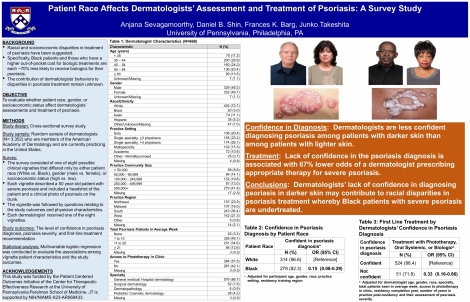Anjana Sevagamoorthy
Dermatologists’ Assessment and Treatment of Psoriasis Differ by Race
Abstract
The contribution of dermatologists’ practices to existing disparities in psoriasis treatment remains unknown. We aimed to evaluate whether patient race, gender, or socioeconomic status affect dermatologists’ management of psoriasis. We conducted a cross-sectional survey study of a random sample of dermatologists (N=3,352) who are members of the American Academy of Dermatology. The survey included a vignette that described and visually depicted a 50-year-old person with severe psoriasis followed by questions that assessed the dermatologist’s confidence in the diagnosis of psoriasis and first line treatment recommendation. Each dermatologist received one of eight survey options that differed only by either patient race (White vs Black), gender (male vs female), or socioeconomic status (high vs low). We performed multivariable logistic regression to evaluate the associations among patient characteristics and the dermatologist’s confidence in psoriasis diagnosis and treatment recommendation. The survey response rate was 19.9% (N=668). Dermatologists who received the Black patient vignette were less likely to be confident in the diagnosis of psoriasis compared to those who received the White patient vignette (odds ratio [OR] 0.15, 95% confidence interval [CI] 0.08-0.29). Diagnostic uncertainty was associated with lower odds of recommending appropriate treatment for severe psoriasis with phototherapy, oral systemics, or biologics (OR 0.33, 95% CI 0.16-0.66), independent of other patient and dermatologist characteristics. Our findings identify greater uncertainty among dermatologists in diagnosing psoriasis among Black patients compared to White patients. This diagnostic uncertainty may, in turn, contribute to existing racial disparities in psoriasis treatment and disproportionate undertreatment among Black patients with psoriasis.
Keywords
disparities skin of color psoriasis dermatologist's assessment and treatmentCommenting is now closed.
About Us
To understand health and disease today, we need new thinking and novel science —the kind we create when multiple disciplines work together from the ground up. That is why this department has put forward a bold vision in population-health science: a single academic home for biostatistics, epidemiology and informatics.
© 2023 Trustees of the University of Pennsylvania. All rights reserved.. | Disclaimer




Comments
Thank you! Regarding your question, we tested for difference in the outcomes by physician race and did not see any association. Difference by age is something we did not look at, but that is an interesting thought and will consider exploring a little more into. At the time of this study, we concurrently explored Atopic dermatitis and we are looking to do the same with acne going forward. With AD, we had some interesting findings as well whereby we saw that Black and female patients were less likely to be identified as having severe eczema compared to white and male participants, and Black participants were less likely to be treated with non-topical therapy compared to white patients.